Email Marketing
The State of Email Marketing Teams in 2023 | Inbox Insights Results

Email Marketing

How many email marketers does it take to change a lightbulb?
That is not a question we asked senders in the Inbox Insights 2023 survey. So, you’re going to have to come up with your own punchline. We did, however, ask a bunch of relevant questions and got some interesting results. (No joke.)
You can download the full Inbox Insights 2023 report from Sinch Mailjet for free. But here, we’re going to explore some of the findings centered around email marketing teams.
Successful email marketing requires a lot of different skills. That includes strategy, design, copywriting, coding, customer research, and data analysis. So, what does it take to be part of a successful email marketing team? Let’s dig into some survey results.
We know what you’re thinking… Our email marketing team is anything but typical. We hear you. Email geeks and email freaks, amiright?
What we’re actually looking at here is a breakdown of email team sizes in this survey. We’ll use these segments to explore how different types of teams operate. What do their challenges, goals, and processes look like?
Out of the more than 3,200 people who completed the Inbox Insights 2023 survey, around one third are One-person email teams, which means they do it all and wear multiple hats. It’s likely many of these respondents are responsible for other marketing efforts and channels as well. One-person email teams may also represent freelancers and solopreneurs.
The most common email marketing team size is Two to five people (42.8%). A typical email team of four could include someone who writes, someone who designs, someone who codes, and someone who manages and strategizes. Around two-thirds of respondents are working on email marketing with at least one other person.
A substantial number of people on larger email marketing teams participated in the survey as well. Nearly 14% come from teams of Six to ten while 10% work on teams of 10 or more people.
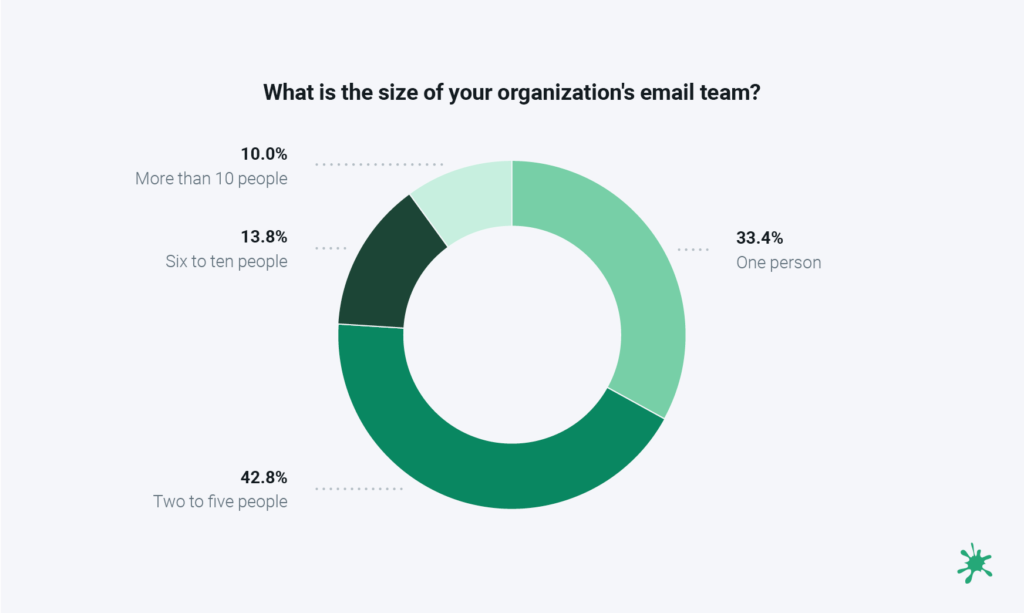
As you’d expect, the larger email teams almost always come from bigger companies. Whereas the smaller teams are usually from small-to-medium sized businesses (SMBs). The makeup of larger email teams could include a variety of job roles. Here’s a look at some typical titles and the percentage of respondents in the survey:
There were also respondents who work in IT, Operations, and nearly 800 people who called themselves business owners.
Does size matter? When it comes to email program success, that seems to be the case.
As you can see below, survey participants from larger email teams were noticeably more likely to say their efforts have been successful in the last year. While nearly 80% of teams with more than 10 people said their email programs were Very or Somewhat successful, less than half of one-person email teams could say the same.
Among the most-common email team size of two to five people, just over 60% said their programs were Very or Somewhat successful last year. However, no more than 16% of any email team size saw their efforts as Very or Somewhat unsuccessful.
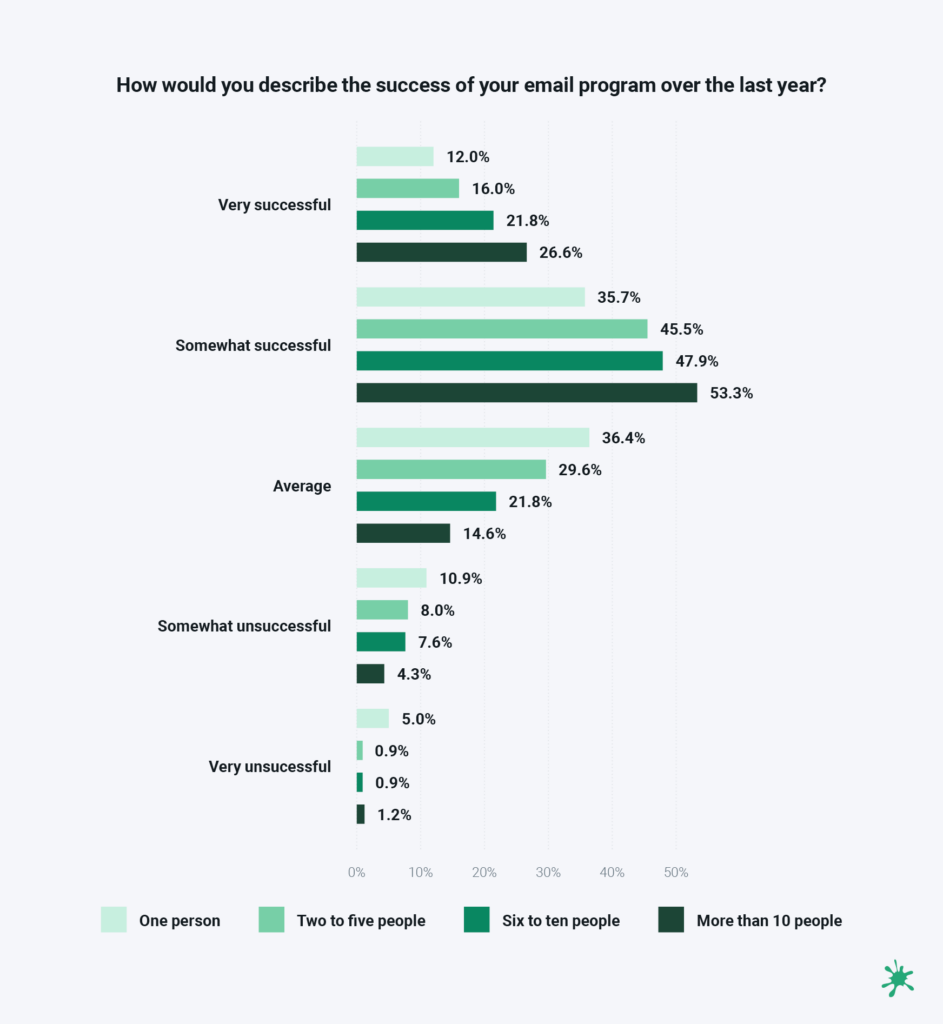
The metrics you use to measure email performance will have a major influence on how you define success. We asked survey participants to pick up to three of the most important email metrics and some clear differences emerged among team sizes.
Inbox Insights 2023 found that smaller teams are much more likely to call opens and clicks the most important email metrics. Smaller email marketing teams also placed a somewhat higher importance on using conversion rates as a measure of success.
Those from the largest email teams were more likely to focus on following the money. At 36.4%, Revenue from email was chosen more often by teams of 10+ than any other metric. Clickthrough rate was still a popular choice for larger email teams, but they are also more likely to be monitoring List growth and return on investment (ROI) from email marketing.
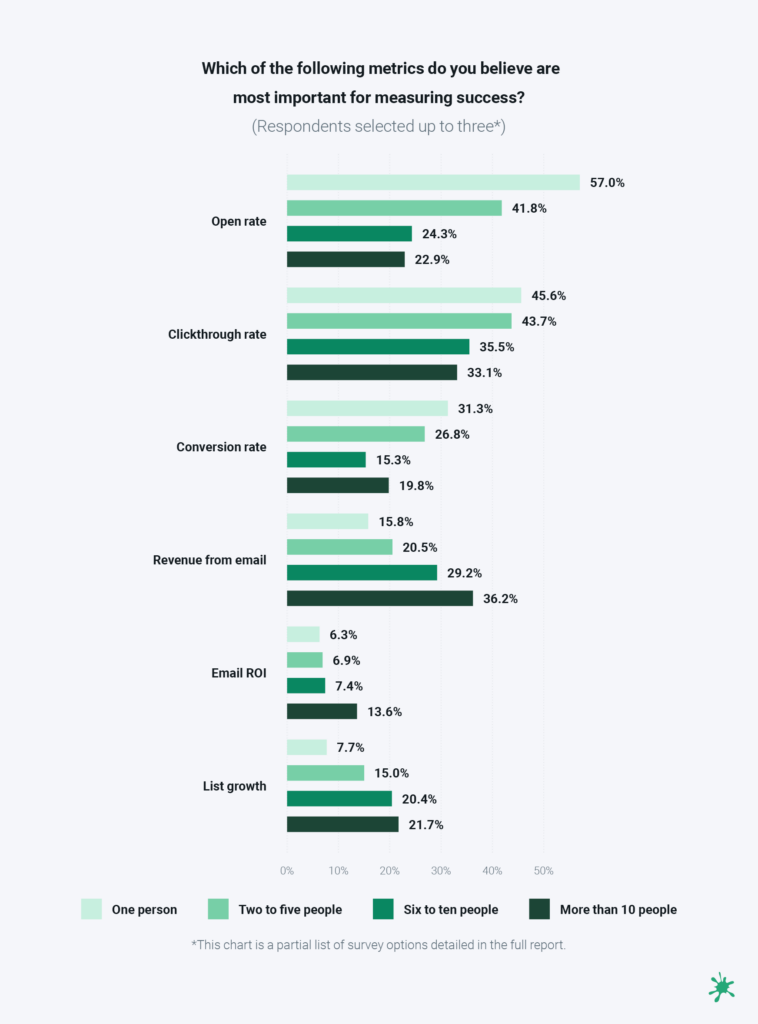
While you might want to jump to the conclusion that email marketers from big brands only care about cold hard cash, that’s probably not the case. Instead, it could be an indication of more advanced email programs.
If you’re the only one in charge of email marketing, you may not have the tools and resources to easily attribute revenue to the channel. Measuring the true ROI of email could be even more difficult. However, those working for enterprise organizations with larger email teams are not only going to place more importance on revenue generation, but they also have the tools and data analysts to accurately measure it.
Measurement also seems to be a bigger deal for businesses with big email teams. 44% of email teams with more than 10 people said the Ability to measure performance/ROI is one of the top three contributors to their success. Only 18% of one-person email teams chose that option.
In addition to what contributes to email success, the Inbox Insights 2023 report also explores what holds senders back from achieving the success they expect.
For smaller email teams, the ongoing struggle of Standing out in the inbox rose to the top of the list of constraints. Teams of 6 to 10 people were the most likely to report being constrained by a lack of support, investment, time, and focus.
The largest email teams of 10+ people are more concerned with constraints connected to data privacy and security. That may be due to the fact that compliance is more complicated in enterprise businesses. Following CCPA and GDPR guidelines is important for international organizations. And larger, recognizable companies tend to be common targets of phishing attacks as well as email brand spoofing.

Overall survey results found that Design and copy (34.7%) edged out Improving deliverability (34.4%) for the top contributors to email program success. But email design and development come with many unique and often complex challenges.
When asked to select their three biggest email design and development challenges, teams of all sizes agreed that developing responsive emails and inconsistent email client rendering can be real problems. Every team size selected those two issues more than 30% of the time. In the full survey, Responsive emails was chosen as a top challenge 36% of the time and 35% of respondents chose Inconsistent rendering as a significant challenge.
But where do challenges for various email team sizes differ? Inbox Insights 2023 found the largest teams were more likely to have specific Email coding challenges (35.3%). Email accessibility and dark mode are also significant challenges for larger teams.
Since email teams with only one person may not have the time and talent to code their own campaigns from scratch, they’re spending time trying to find templates and struggling to add interactivity to emails.

While collaboration between designers and developers was the least common challenge in the survey, that’s still a top issue for more than 15% of the largest email teams. It’s no big secret that the larger your team gets, the more challenging teamwork and communication become. In fact, a 2020 study from Holistic and Sinch Email on Acid found that larger email teams were more likley to make mistakes.
There can be advantages to working as a solo email marketer. The most obvious one? Speed.
Inbox Insights 2023 found that the smallest email teams are able to get the job done fastest. Almost 70% of one-person email teams say they can complete the campaign production process in less than a week. When you’re the only one responsible for email marketing, you don’t have to wait on teammates to keep the process moving. You don’t have to worry about reviews and approvals either. That kind of autonomy is empowering and scary at the same time.
The most common email production time is between one and two weeks. In our survey question, we clarified that this includes the time it takes to conceptualize, write, design, code, test, and launch a new email marketing campaign. Interestingly, just over 19% of email teams with 10+ people say that the entire process takes them more than a month. However, 29% of respondents in that same group say they can complete the process in less than a week.

One factor that may help teams speed up the production process is a defined email design system.
When we asked respondents if they’re using a design system, the overall survey results found that around 36% are always using one, nearly 20% never use a design system, and more than 5% don’t know if they’re using an email design system (or don’t know what one is).
Here’s what the breakdown looks like based on email team size:

Nearly 58% of email teams with more than 10 people and over 40% of teams with six to 10 people are always using an email design system. Even among one-person email teams, nearly 58% say they are either always or sometimes use a design system.
It’s good to see that design systems have become so common in email marketing. Check out email developer Megan Boshuyzen’s thoughts on how component-driven design systems can make your team even more efficient.
A good email marketing team is always looking for ways to level up their game. We asked survey participants to select the advanced email tactics their teams planned to pursue in the upcoming year. It’s clear that different email team sizes have different priorities.
When it comes to the content of email campaigns, larger email teams plan to use more interactivity in coming months while smaller teams are more likely to look for ways to add animations and video to their strategy.
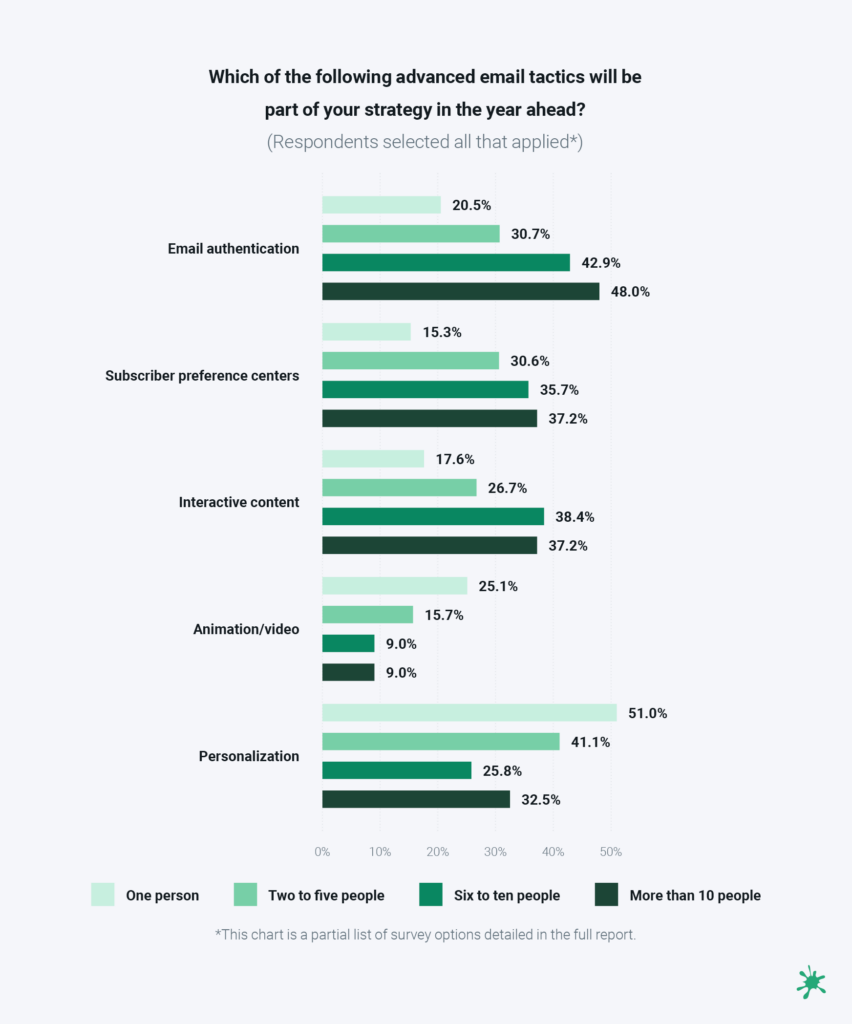
For larger email teams, two primary focuses for the year ahead appear to be connected to the challenges of email security and compliance. 48% of email teams with more than 10 people say they’ll be working on email authentication in 2023. That includes protocols like SPF, DKIM, DMARC, and the BIMI email specification.
Email authentication is crucial for any brand of any size. It has a huge impact on email deliverability and is the best way to stop inbox scammers from spoofing. However, these results suggest bigger companies may be getting more serious about taking authentication further. That could include implementing a stronger DMARC policy.
Subscriber preference centers are also more popular the larger the email team becomes. These centers can help make your subscribers’ inbox experiences more relevant. It ensures they only receive the communications they want to receive, which ultimately increases engagement and supports sender reputation.
More than half of one-person email teams (51%) want to use personalization in the coming year. These are most likely senders who want to begin personalizing emails or they are planning to enhance their personalization strategy. Out of all Inbox Insights survey respondents, only 15% said they were not using personalization at all.
So, if 85% of senders are using personalization, what can email teams do to make their use of this tactic stand out? Inbox Insights also asked respondents to identify the types of emails they’re personalizing and the kind of subscriber they use.
More than half of email teams that include two to five people are using subscribers’ names for personalization, that number jumps to more than 75% of one-person teams. However, larger teams were less likely to select that option. While name personalization was the most popular method, it’s clear that larger teams from bigger brands are trying to take email personalization further.
Teams with more advanced personalization strategies are looking at factors such as past purchases, application usage, content consumption, and other data from the website. Using those kinds of datapoints for personalization opens the door to a much wider range of possibilities.
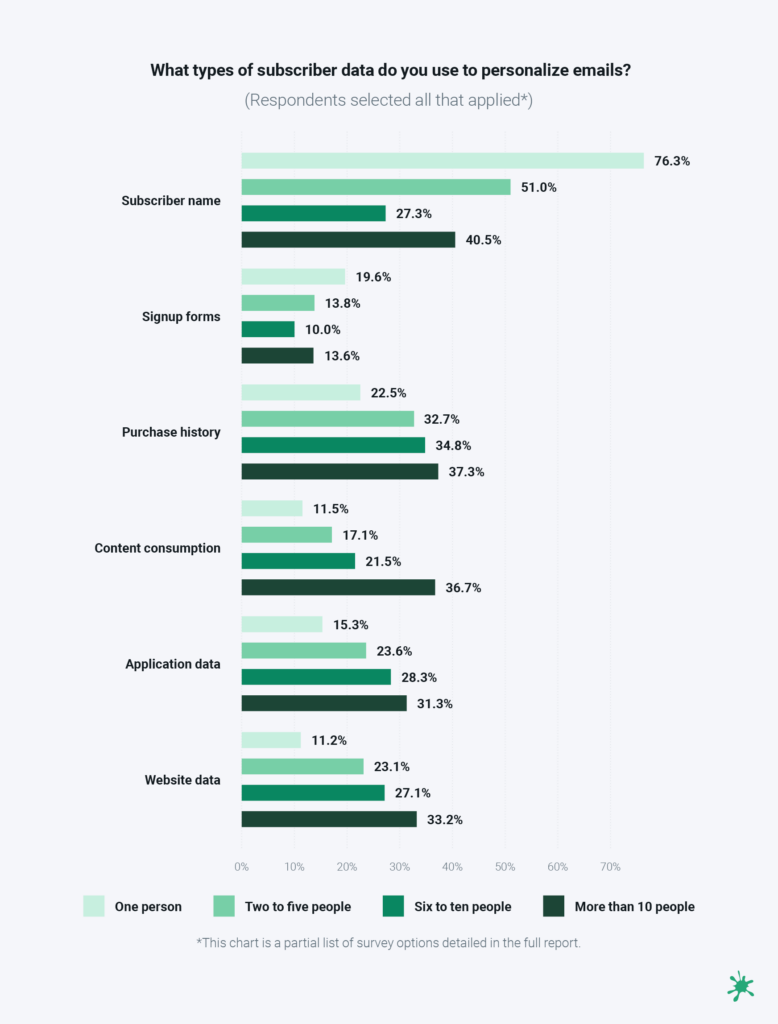
A name in a subject line or body copy might give the appearance of a personalized email, but a truly personalized experience will make your contacts feel like the email was created just for them.
It’s worth noting that our survey results also suggest there are plenty of one-person email teams using advanced personalization tactics. There are tools out there that make it possible for any email marketer to start personalizing campaigns. Check out the personalization possibilities with Sinch Mailjet.
You might be a superhuman email marketer doing it all yourself. Or you could be a linchpin in a well-oiled email marketing team machine. Either way… we all make mistakes. But a mistake in an email campaign can mean lost revenue and a damaged brand reputation.
Sinch Email on Acid is here to help you catch the most common email marketing problems before you hit that send button. Our email quality assurance platform is a useful tool for all types of email teams.
If you’re a one-person email team, you can use the platform as a safety net to catch everything from typos to code issues. And if you’re part of a bigger team, Email on Acid is ideal for collaborating on the campaign review and approval process. Check out our team management features to learn more.
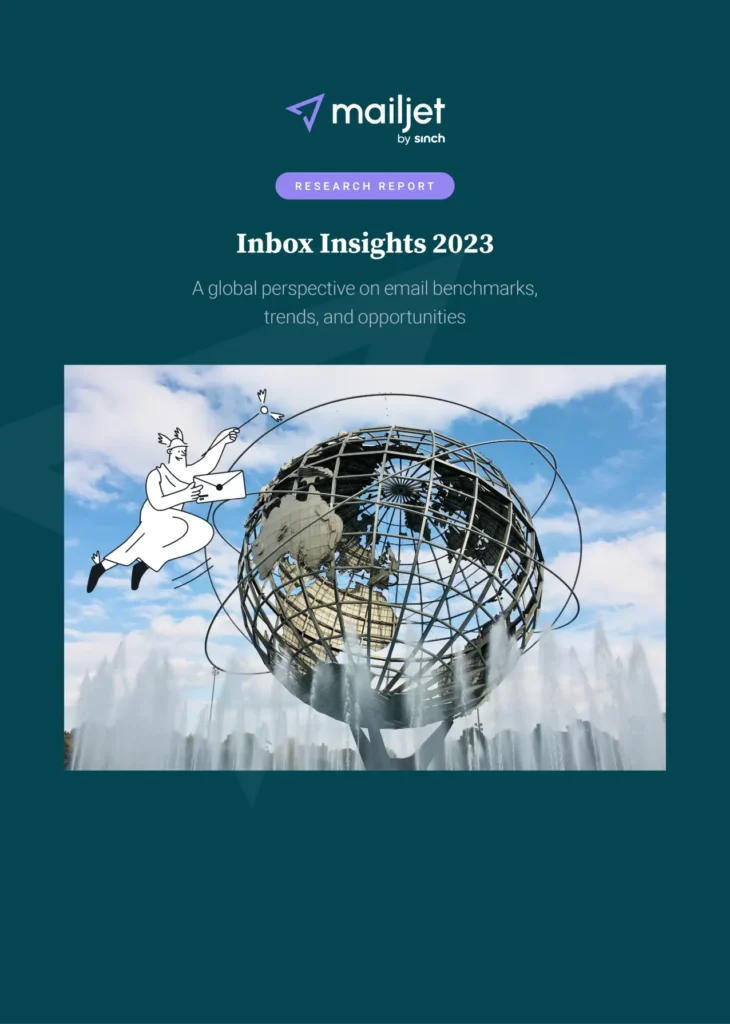
Don’t miss the rest of the results from our global survey of email senders. Inbox Insights 2023 explores the state of email across regions and industries.
In the full report, you’ll find: